Abstract
The asphalt concrete flexible pavement consists of many layers interconnected by tack coat binder. The resistance of the bonding tack coat to the impact of moisture that ingress through the cracks into the interface of asphalt concrete can cause premature matrix degradation of pavement structure. In this investigation, the influence of moisture susceptibility on the bond strength and horizontal deformation of three layers of asphalt concrete are assessed under repeated shear stresses. The suitability of two types of tack coat (Rapid curing cutback RC-70 and medium setting cationic emulsion CMS) to support the resistance to moisture damage have been investigated. Asphalt concrete slab specimens have been prepared with the aid of roller compactor for the typical three layers usually implemented in flexible pavement in Iraq (wearing, binder and asphalt stabilized base courses) with (12, 19.5 and 25) mm nominal maximum size of aggregate. Layers were bonded by tack coat after construction of the bottom layers. Core specimens have been obtained and subjected to moisture damage then practiced 1200 cyclic shear stresses in the Pneumatic Repeated Load System PRLS using a special manufactured mold. Control core specimens have been obtained and practiced 1200 cyclic shear stresses. Specimens were tested for bond shear strength. The bond shear strength and horizontal deformation under repeated shear stresses were analyzed and compared. It was concluded that the horizontal permanent deformation increases by a range of (4 -27) % and (2-57) % after moisture damage when RC-70 and CMS tack coat were implemented respectively at various application rates. However, the reduction in bond shear strength due to moisture damage ranges between (2-17) % and (5 -30) % for RC-70 and CMS Tack coat interfaces. CMS tack coat exhibits higher bond shear strength ratio BSSR than RC-70 tack coat for all the application rates and is recommended for use from the moisture susceptibility point of view.
Keywords: Moisture Susceptibility; Interface; Asphalt Concrete; Bond Shear; Horizontal Deformation; Tack Coat;
Introduction
Flexible pavement consists of multilayers of asphalt concrete bonded by tack coat; the layers are generally a dense graded mixture. Tack coat is generally applied to provide good bonding between the upper and underlying layer as reported by Alvarez et al. [1]. Because of the interconnected air voids, and possible cracks, rainwater may drain vertically through to the underlying layer and then laterally to the edge of the pavement. Many types of tack coat materials, including emulsion, cutback among which asphalt is the main component in a tack coat material and provides the required bonding properties as concluded by Wang et al. [2]. Moisture damage has long been recognized as one of the major concerns for asphalt pavements as mentioned by Huang et al. [3]; and Shu et al. [4]. Two moisture damage mechanisms are already identified including pore pressure which causes microcracks and displacement, and water diffusion which causes detachment between asphalt binder and aggregate as reported by Caro et al. [5]. Several failures may occur due to moisture damage, including stripping, cracking, and raveling. To control the moisture damage impact, the air voids size distribution is considered as a critical factor affecting the moisture resistance. Masad et al. [6] found that moisture damage is maximized when air void size is in the range of 1.2–1.4 mm for granite and 0.8–1.0 mm for limestone. Research by Zhang et al. [7] indicated that mineral composition and surface characteristics of aggregates both affected the bonding with the asphalt binder, and mineral composition appears to be more important than aggregate morphology. The asphalt binder type and additive also affect the bonding performance during a moisture damage process as concluded by Canestrari et al. [8]. The direct shear test was performed by Song et al. [9] on the conditioned specimens using the AASHTO [10] procedure with one freezethaw cycle, which is considered more severe and could accelerate moisture damage. The vacuum-saturated water was controlled at 20% instead of 70–80%. After the freeze-thaw conditioning, the direct shear test was performed. It was observed that the bonding performance between layers degraded substantially after one cycle of freeze-thaw conditioning. It was concluded that the shear strength of the conditioned specimens decreased about 14% compared to the unconditioned specimens. As reported by Rapp [11], moisture was found to reduce the bond strength between 15 and 30%. Temperature was detected to be critical, especially in case of weak bond and bond defects. Therefore, it was suggested as part of the testing standards to consider additional testing at low temperature (e.g. -20°C). It was stated that as water conditioning at 40°C or 60°C has a negative effect on the interlayer shear bond leading to reduced shear force and shear stiffness. For 72 h water conditioning at 40°C the reduction in shear force and shear stiffness at the investigated pavement interfaces was found to be between 2% and 20% respectively while 72 h water conditioning at 60°C led to reductions in shear force of 15% to 25%. Copeland et al., [12] described the water damage in asphalt mixes as the cohesive failure in the mastic, adhesive failure at the asphalt-aggregate interface, and breakdown of aggregates. An investigation by Sarsam and AL Nuaimi, [13] has reported that the base course requires rate of application of 0.23 liter/m2 of cationic emulsion asphalt as an optimized requirement while the binder course requires 0.23 liter/ m2 of emulsion asphalt as an optimized requirement. However, when rapid curing cutback was implemented, Asphalt concrete binder course laid on base course exhibit the highest shear strength of 1600 kPa at an application rate of 0.33 liter/m2, while asphalt concrete wearing course laid on binder course exhibit the highest shear strength of 1515 kPa at an application rate of 0.15 liter/ m2. On the other hand, when emulsion was implemented as tack coat, asphalt concrete binder course laid on base course exhibit the highest shear strength of 1620 kPa at an application rate of 0.23 liter/m2 while the asphalt concrete wearing course laid on binder course exhibit the highest shear strength of 2272 kPa at an application rate of 0.23 liter/m2.
The aim of the present investigation is assessing the influence of moisture susceptibility on the bond strength and horizontal deformation of three layers of asphalt concrete is assessed under repeated shear stresses. The suitability of two types of tack coat (Rapid curing cutback and cationic emulsion) to support the resistance to moisture damage has been investigated.
Materials and Methods
Asphalt Cement
The asphalt cement used in this study is brought from AL Dura refinery, south of Baghdad. Penetration graded binder of 40-50 is implemented. The physical properties of the asphalt cement are presented in Table 1.
Cut Back Asphalt
Cut back is asphalt cement which has been blended with petroleum distillates. In this study, tack coats RC70 which is widely used in Iraq, is implemented. Such cut back is prepared by mixing one gasoline ratio into two ratios of asphalt cement (85 -100) measured in volume. The physical properties of the RC70 are presented in Table 2. Three application rates of (0.15, 0.33, 0.5) liter/m2 have been implemented which are within the limitations of State Commission for Roads and Bridges, SCRB, [15].
Cationic Emulsion
Medium setting cationic emulsion has been implemented as tack coat. This classification is based on the rate of breaking of the emulsion. The physical properties of emulsion are illustrated in Table 3. Three application rates of (0.1, 0.23, 0.35) liter/m2 have been implemented which are within the limitations of SCRB, [15].
Coarse Aggregate
The coarse aggregates (uncrushed) for base layer and (crushed) for binder and wearing layers are obtained from AL-Nibaee quarry. Coarse aggregates consist of hard, strong, and durable pieces, free of coherent coatings. The size of course aggregate range between (25 mm) and retained on sieve No. 4 (4.75mm) according to SCRB R/9, [15] specification. The physical properties of the coarse aggregate are illustrated in Table 4.
Fine Aggregate
A combination of crushed and river sand fine aggregate was obtained from AL-Nibaee quarry. The fine aggregate ranges between 4.75mm (No.4) sieve and retained on 0.075mm (NO.200) sieve. It consists of durable, tough, and angular grains free of clay, loam, or other deleterious substance according to SCRB, [15] specifications. The physical properties of the fine aggregate are shown in Table 4.
Table 1: Physical Properties of Asphalt Cement
Test condition |
ASTM, [14] |
Units |
SCRB, [15] |
Test |
|
Penetration |
100gm, 25Co , 5 sec (1/10mm) |
D-5 |
1/10mm |
40-50 |
46.5 |
Specific Gravity |
@ 25 °C |
D-70 |
gm/cm3 |
-------- |
1.05 |
Flash point |
____Cleveland open cup |
D-92 |
°C |
>232 |
285 |
Ductility |
25 °C, 5cm / min |
D-113 |
cm |
>100 |
>150 |
Softening point |
Ring and ball |
D-36 |
°C |
------- |
48 |
Kinematic viscosity |
@135°C |
D2170 |
C. Stoke |
-------- |
230 |
Residue after thin film oven test |
|||||
Penetration of residue |
100gm, 25C , 5 sec (1/10mm) |
D 5 |
1/10mm |
40 – 50 |
36.5 |
Ductility of residue |
25 °C, 5cm / min |
D113 |
cm |
>55 |
145 |
Loss in weight |
5 hours at 163 Co,50 gm |
D 1754 |
% |
<0.75 |
0.13 |
Table 2: Physical Properties of RC-70 Cut Back
Test |
ASTM, [14] Designation |
Cut Back Asphalt |
Specification Limits ASTM, [14] |
|
Minimum |
Maximum |
|||
Density (gm/liter) |
D2028, D3142 |
995 |
--- |
--- |
Water concentration (%) |
D95 |
0.1% |
--- |
0.2% |
Residual by Evaporation( %) |
D2028 |
90% |
55% |
--- |
Kinematic viscosity (C. Stoke) |
D2170 |
75 |
70 |
95 |
Table 3: Physical Properties of Emulsion
Property |
ASTM, [14] Designation |
Test Result |
Limits |
Emulsion type |
D2397 |
Cationic (CMS) |
Medium setting |
Residue by evaporation % |
D6934 |
54 |
Min 40 |
Specific gravity, gm/cm3 |
D70 |
1.04 |
------- |
Penetration (mm) |
D5 |
219 |
100 - 250 |
Ductility(cm) |
D113 |
46 |
Min 40 |
Viscosity, Saybolt-Furol viscometer @ 50 °C – AASHTO, [16] |
AASHTO M208 |
348 |
110 - 990 |
Solubility in Trichloroethylene (%) |
D2042 |
97.7 |
Min 97.5 |
Emulsified asphalt / job aggregate coating practice |
D244 |
Fair |
Good |
Table 4: Physical Properties of Aggregates
Property |
Coarse Aggregate |
Fine Aggregate |
SCRB, [15] Limitations |
Bulk Specific Gravity(ASTM C-127 and C128) |
2.61 |
2.632 |
--------- |
Apparent Specific Gravity (ASTM C127and C128) |
2.657 |
2.693 |
--------- |
Percent Water Absorption (ASTM C-127 and C128) |
0.443 |
0.526 |
5 % Max. |
Percent Wear (Loss Angeles Abrasion)(ASTM C-131) |
18.6 |
-------- |
35 - 45 |
Percent Sand equivalent D2419 |
--------- |
55 |
45 min |
Angularity for coarse aggregate ASTM D5821 |
96% |
------- |
90 min |
Percent flat and elongated particles D4791 |
Flat |
3% |
<10% |
Elongation |
5% |
5 - 1 |
Mineral Filler
Ordinary Portland cement was implemented as mineral filler. It is thoroughly dry and free from lumps or aggregation of fine particles. The physical properties of filler are shown in Tables 5.
Table 5: Physical Properties of Portland Cement Filler
Property |
Test Result |
% passing Sieve No.200(0.075mm) |
97 |
Specific Gravity, gm/cm3 |
3.14 |
Specific Surface Area (m2/kg) |
310.5 |
Combined Gradation of Asphalt Concrete
The coarse and fine Aggregates used in this study were separated to different sizes by sieving, then recombined in the proper proportions to meet the Base, binder, and Surface course gradations. Figure 1 exhibit the aggregates gradations used to prepare mixtures for wearing, binder and, base courses respectively as per SCRB, [15].
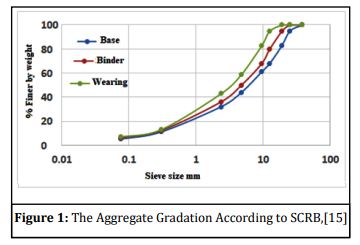
Preparation of Asphalt Concrete Mixtures
The aggregates were dried in an oven to a constant weight at 110ºC, then sieved to different sizes, and stored separately. Coarse and fine aggregates were combined with mineral filler to meet the specified gradation of asphalt concrete layers as per SCRB, [15] specifications. The combined aggregate mixture was heated to 150ºC before mixing with asphalt cement. The asphalt cement was heated to the same temperature of 150ºC, then it was added to the heated aggregate to achieve the desired amount and mixed thoroughly using mechanical mixer for two minutes until all aggregate particles were coated with thin film of asphalt binder. Marshall Specimens were prepared in accordance with ASTM D1559, [14] using 75 blows of Marshall Hammer on each face of the specimen for binder and wearing course mixtures. However, 50 blows of Marshall Hammer on each face of the specimen for base course mixture was used. Specimens were tested for Marshall and volumetric properties, and the optimum asphalt content for each mixture was obtained. Table 6 exhibits the Marshall properties of asphalt concrete mixtures.
Table 6: Marshall Properties of Asphalt Concrete Mixtures
Layer |
Wearing |
Binder |
Base |
Marshall Stability kN |
10.1 |
9.8 |
8.8 |
Unit weight |
2.354 |
2.346 |
2.325 |
Air voids % |
4.15 |
4.2 |
4.4 |
Flow mm |
3.5 |
3.5 |
3.4 |
VMA % |
15 |
14.6 |
13.7 |
VFA % |
72 |
71 |
69 |
Optimum asphalt content % |
5 |
4.7 |
4.3 |
Preparation of Asphalt Concrete Slab Samples and Core Specimens
Two types of asphalt concrete Slab specimens of (400 mm by 300 mm) were prepared using the roller compactor. The first type consists of base course of 80 mm thickness overlaid with binder course of 40 mm. the second type consists of binder course of 60 mm overlaid with wearing course of 40 mm. Pneumatic Roller Compactor B3602-DYNA, Ver 1.14, was implemented to prepare slab samples. Roller compaction was adopted as per EN12697- 33, [17] with a static load starting from 2.4 kN for 10 cycles. The load was increased each 10 cycles to reach 9.1 kN for a total of 33 cycles to meet the target density of the layer at optimum asphalt content. The compaction temperature was maintained to 135 °C. Figure 2 shows the roller compactor implemented. After the base course slab of the first type or the binder course of the second type were compacted, the slabs were left for 24 hours to cool at laboratory environment. Then the compacted slabs for each type were subjected to tack coat application at the specified application rate and tack coat type. Samples were left for 120 minutes to cure the tack coat, then overlaid by binder or wearing course mixtures and subjected to the roller compaction to the target density as explained above. Slab samples were left for 24 hours at the laboratory environment to cool. Six core specimens of 110 mm diameter were cut by the Diamond saw to the full depth of the slab which consists of two courses of asphalt concrete. The total number of slab samples prepared was 12 while, the total number of core specimens was 72. Figure 3 exhibits part of the prepared slab samples, while Figure 4 shows part of the obtained core specimens. Figure 5 demonstrates tack coat application process.
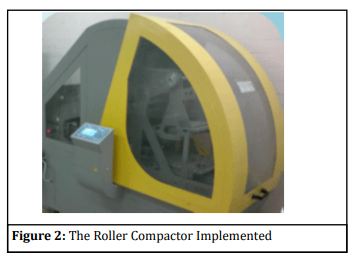
Testing for Resistance to Moisture Damage
The asphalt concrete core specimens were subjected to moisture damage as per the procedure described by AASHTO, [16]. The core specimens were divided into two groups, the first group was denoted as unconditioned specimens which was subjected to cyclic shear stresses at 20°C. The second group of Asphalt concrete core specimens were immersed in water at 25°C into the desecrator and subjected to saturation under vacuum pressure of 3.74 kPa for ten minutes, then the specimens were removed from the water chamber and stored in a deep freezer for 16 hours at (-18)°C. Specimens were withdrawn from the deep freezer and allowed for thawing for 120 minutes in air then specimens were transferred into a water bath and stored for 120 minutes at 60ºC. Specimens were denoted as conditioned specimens then stored at 20°C for 120 minutes before practicing cyclic shear stresses.
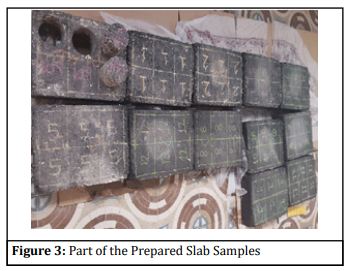


Cyclic Shear Stresses Test
Core Specimens were subjected to the cyclic shear stresses according to the procedure implemented by Sarsam and AL Nuaimi, [13]. Shear test device consist of testing mold shown in Figure 7, which was designed and manufactured at local market and implemented to evaluate interface shear strength. The test involves the application of a direct cyclic shear stress and the resulting shear displacement during the test was monitored. The mold and the asphalt concrete core specimen are placed in an environmental chamber capable of controlling the temperature to within 20 ±0.5°C. The test mechanism is such that one layer is held stationary in the mold while the other layer is loaded with a specific shear displacement rate. The specimens that were used in this study had a diameter of 110 mm and variable length of (100-120) mm based on testing combination of pavement layers. Specimens were seated in the pneumatic repeated load system PRLS chamber shown in Figure 6. Cyclic shear stress is applied with a constant loading frequency of 60 cycles per minute and loading sequence for each cycle is 0.1 sec load duration and 0.9 sec rest period. Load repetitions were applied under constant stress level of 0.138 MPa, while the testing temperatures of 20ºC were maintained throughout the test. Such timing and test conditions were suggested by Sarsam and Husain, [18]. Specimens were subjected to the application of cyclic shear stresses for 1200 load repetitions and the permanent deformation was monitored. Figure 7 exhibit the Interface Bond Shear Strength Testing mold. After 1200 load cycles, the test was terminated. A digital video camera was fixed on the top surface of the (PRLS) to capture dial gage reading. The average permanent deformation of duplicate specimens was considered.


Bond Shear Strength Ratio
The procedure of this test was similar to the tensile strength ratio procedure conducted according to ASTM D4867, [14] to evaluate the moisture damage of mixture. Six core specimens for each tack coat type and application rate were prepared, three of them were tested for bond shear strength after placing in water bath at 25˚C for 30 minute and the average value of was considered for these specimens as SI (bond shear strength for unconditioned specimens). The other three specimens were conditioned by placing in the volumetric flask with (heavy –wall glass) of 4000 ml capacity filled with water at room temperature 25˚C and the vacuum of 28 mm Hg (3.74kPa) was applied for 10 minutes so that 80 %-degree level of saturation could be attained. The three specimens were placed in deep freezer at -18˚C for 16 hours, then specimens were removed from the freezer and placed for 24 hours in water bath at 60˚C, then they were moved to another water bath and placed for 1 hour at 25˚C. The specimens were tested for bond shear strength and the average value was considered as SII (bond shear strength for moisture conditioned specimens). The Bond Shear Strength Ratio BSSR was calculated using equation (1).
Bond Shear Strength Ratio BSSR = SI/SII x 100 (1)
Where:
BSSR= Bond Shear Strength Ratio (%)
SI= Average value of bond shear strength for conditioned specimens (kPa)
SII= Average value of bond shear strength for unconditioned specimens (kPa)
Interface Bond Shear Strength Test
The test involves the application of a direct shear load and the resulting shear displacement during the test was monitored. The mold and the asphalt concrete specimen are placed in an environmental chamber capable of controlling the temperature to within 20 ±0.5°C. The test mechanism is such that one layer is held stationary in the mold while the other layer is loaded with a specific shear displacement rate. The core specimens that were used in this study had a diameter of 110 mm and variable length of (100-120) mm based on testing combination of pavement layers. Testing was conducted at 20°C at a constant loading rate of 5 mm/min. The test setup and testing mold are shown in Figure 8. The interface bond shear strength is calculated by dividing the maximum load sustained by the specimen before failure by the cross-sectional area of the specimen. Similar testing mold and procedure was reported by Biglari et al., [19] and Mirsayar et al., [20].

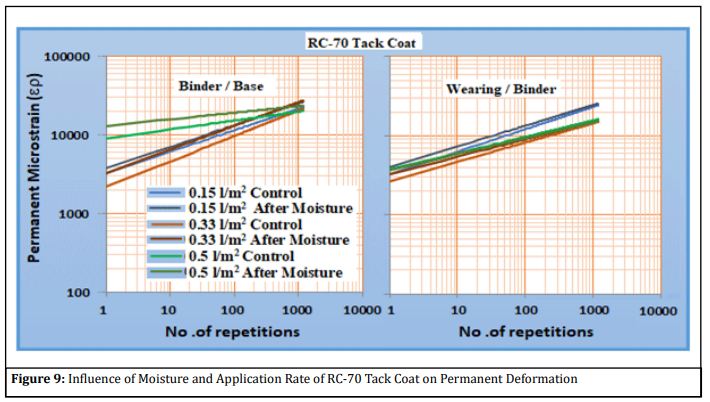
Results and Discussion
Influence of Moisture Damage and RC-70 Tack Coat on Permanent Deformation Parameters
Figure 9 demonstrates the influence on moisture damage and application rate of RC-70 tack coat on horizontal permanent deformation at the interface of asphalt concrete. It can be observed that for binder/base interface, significant variation in the intercept which represent the permanent deformation after the first load repetition among application rate of tack coat. The slope which represents the rate of deformation is sharp at lower application rate of the tack coat while it changes to gentle slope at higher application rate. Such behavior may be attributed to optimum requirement of tack coat for the base course layer which exhibit coarse texture and requires more tack coat for the bond. The variation in the total permanent deformation was not significant after 1200 load repetitions regardless of the application rate or moisture damage. On the other hand, the wearing/binder interface exhibit sharp slope while the variation in the intercept is not significant. This could be attributed to the fine texture of the binder course. Higher total permanent deformation could be observed for lower application rate of tack coat. Table 7 exhibit the impact of moisture damage on the permanent deformation parameters.
It can be noted that the intercept and the total permanent deformation increases after the interface has practiced moisture damage regardless of the application rate or interface type. The horizontal permanent deformation increases by (4.3, 9.4, 3.7) % and (2.1, 27, 16) % for binder / base and wearing / binder interfaces at an application rate of (0.15, 0.33, 0.5) liter/meter 2 respectively.
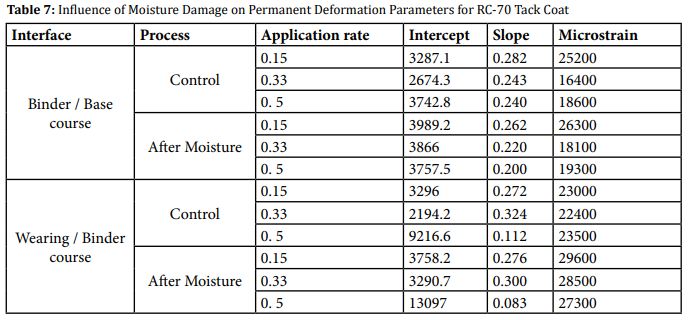
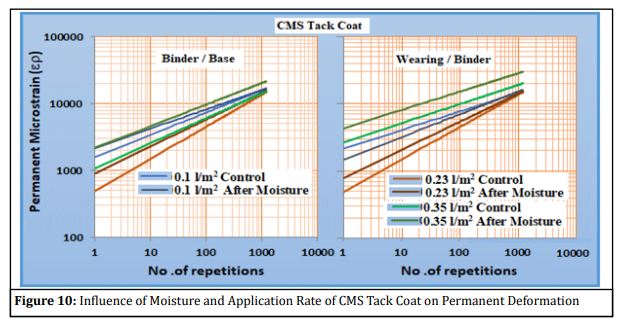
Influence of Moisture Damage and CMS Tack Coat on Permanent Deformation Parameters
Figure 10 demonstrates the influence on moisture damage and application rate of CMS tack coat on horizontal permanent deformation at the interface of asphalt concrete. It can be observed that both interfaces exhibit significant variation in the intercept while the intercept increases after moisture damage regardless of the application rate or interface type. The slope is sharp at lower application rate of the tack coat while it changes to gentle slope at higher application rate for both interfaces. The variation in the total permanent deformation was more significant after 1200 load repetitions for wearing / binder interface as compared to the binder / base interface. It can be observed that higher application rate of tack coat exhibits higher permanent deformation for specimens before and after moisture damage. Table 8 exhibit the impact of moisture damage on the permanent deformation parameters.
It can be noted that the intercept and the total permanent deformation increases after the interface has practiced moisture damage regardless of the application rate or interface type. The horizontal permanent deformation increases by (2.1, 2.5, 33) % and (4.5, 3.2, 57.6) % for binder / base and wearing / binder interfaces at an application rate of (0.1, 0.23, 0.35) liter/meter2 respectively.
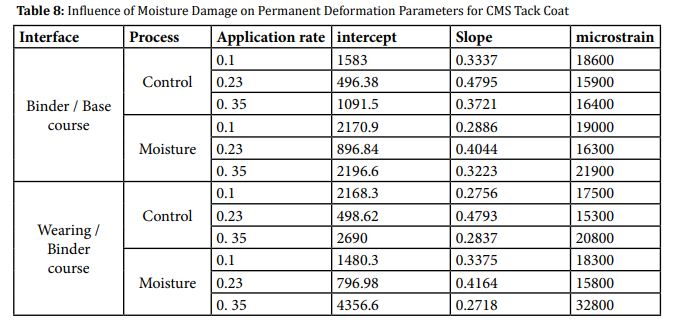
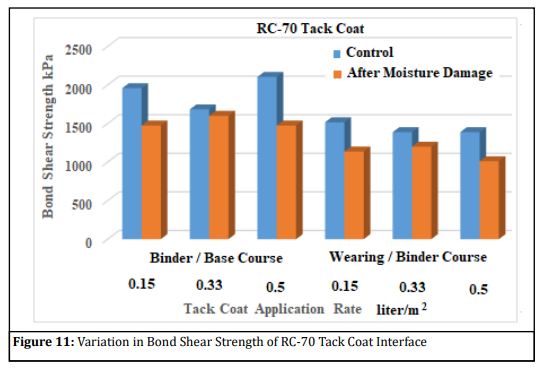
Influence of Moisture Damage on Bond Shear Strength of the RC-70 Tack Coat Interface
The bond shear strength determination was conducted for each core specimen at 20°C environment, Figure 11 demonstrate the variation in the bond shear strength of the interfaces when RC70 tack coat was implemented with various application rates. It can be noted that the bond shear strength declined after moisture damage. However, the binder / base interface exhibits higher bond shear strength as compared to the wearing / binder interface. This may be attributed to the fact that the base course with its coarse texture provides additional bond due to the possible particles interlock in addition to the bonding by the tack coat. The reduction in bond shear strength due to moisture damage ranges between (2- 17) percent for both interfaces. It can be concluded that the lowest reduction in shear strength could be observed at an application rate of 0.33 liter/m2 of RC-70 tack coat regardless of the interface type.
Influence of Moisture Damage on Bond Shear Strength of the CMS Tack Coat Interface
The bond shear strength determination was conducted for each core specimen at 20°C environment, Figure 12 demonstrate the variation in the bond shear strength of the interfaces when CMS tack coat was implemented with various application rates. It can be noted that the bond shear strength declined after moisture damage. However, the binder / base interface exhibits higher bond shear strength as compared to the wearing / binder interface. This may be attributed to the fact that the base course with its coarse texture provides additional bond due to the possible particles interlock in addition to the bonding by the tack coat. The reduction in bond shear strength due to moisture damage ranges between (5 -30) % for both interfaces. It can be concluded that the lowest reduction in shear strength could be observed at an application rate of 0.23 liter/m2 of CMS tack coat regardless of the interface type.
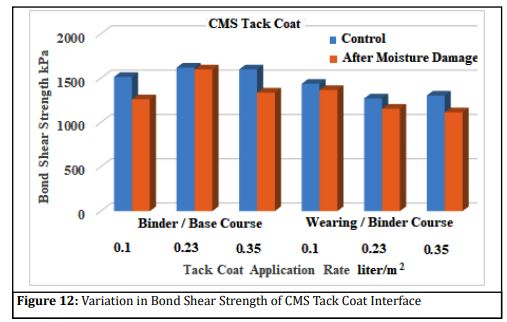
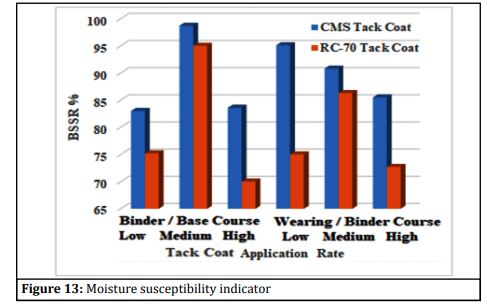
Moisture susceptibility indicator
The bond shear strength ratio is considered as a good indicator for moisture susceptibility of the interfaces of asphalt concrete layers. Figure 13 demonstrates the bond shear strength ratio for the tested interfaces and tack cot types. It can be noted that CMS tack coat exhibits higher bond shear strength ratio BSSR than RC-70 tack coat for all the application rates. The BSSR percentages for CMS tack coat are above 80 % which indicates low moisture susceptibility. On the other hand, the medium rate of application of RC-70 tack coat of 0.33 liter/m2 satisfies the moisture susceptibility requirements as per AASHTO [10] while the lower or higher application rates does not satisfy the requirements.
Conclusions
Based on the limitations of materials and testing program, the following conclusions are drawn.
- The horizontal permanent deformation increases by (4.3, 9.4, 3.7) % and (2.1, 27, 16) % for binder / base and wearing / binder interfaces at an application rate of (0.15, 0.33, 0.5) liter/meter 2 respectively of RC-70.
- The horizontal permanent deformation increases by (2.1, 2.5, 33) % and (4.5, 3.2, 57.6) % for binder / base and wearing / binder interfaces at an application rate of (0.1, 0.23, 0.35) liter/meter 2 respectively of CMS.
- The reduction in bond shear strength due to moisture damage ranges between (2-17) % for both interfaces, while the lowest reduction in shear strength was at an application rate of 0.33 liter/m2 of RC-70 tack coat regardless of the interface type.
- The reduction in bond shear strength due to moisture damage ranges between (5 -30) % for both interfaces, while the lowest reduction in shear strength was at an application rate of 0.23 liter/m2 of CMS tack coat regardless of the interface type.
- CMS tack coat exhibits higher bond shear strength ratio BSSR than RC-70 tack coat for all the application rates, while an application rate of RC-70 tack coat of 0.33 liter/ m2 satisfies the moisture susceptibility requirements.
- CMS tack coat is recommended for various pavement interfaces from the moisture susceptibility point of view.
References
- Alvarez A, Martin A, Estakhri C, Button J, Glover C, Jung C. Synthesis of current practice on the design, construction, and maintenance of porous friction courses. Rep. No. FHWA/TX-06/0-5262-1. College Station, TX: Texas Transportation Institute—Texas A&M Univ. 2006.
- Wang, J, Xiao F, Chen Z, Li X, Amirkhanian S. Application of tack coat in pavement engineering. Constr Build Mater. 2017;152:856–871.
- Huang B, Shu X, Dong Q, Shen J. Laboratory evaluation of moisture susceptibility of hot-mix asphalt containing cementitious fillers. J MaterCiv Eng. 2010;22(7):667–673.
- Shu X, Huang B, Shrum E, Jia X. Laboratory evaluation of moisture susceptibility of foamed warm mix asphalt containing high percentages of RAP. Constr Build Mater. 2012;35:125–130.
- Caro S, Masad E, Bhasin A, Little D. Moisture susceptibility of asphalt mixtures, Part I: Mechanisms. Int J Pavement Eng. 2008;9(2):81–98.
- Masad E, Castelblanco A, BBirgisson. Effects of air void size distribution, pore pressure, and bond energy on moisture damage. J TestEval. 2005;34(1):15–23.
- Zhang J, Airey G, Grenfell J. Experimental evaluation of cohesive and adhesive bond strength and fracture energy of bitumen aggregate systems. Mater Struct. 2016;49(7):2653–2667.
- Canestrari F, Cardone F, Graziani A, Santagata F, Bahia H. Adhesive and cohesive properties of asphalt-aggregate systems subjected to moisture damage. Supplement, Road Mater. Pavement Des. 2010;11(S1):11–32.
- Song W, Shu X, Huang B, Woods M. Influence of interface characteristics on the shear performance between open-graded friction course and underlying layer. J Mater Civ Eng. 2017;29(8):04017077.
- AASHTO. Standard method of test for resistance of compacted asphalt mixtures to moisture-induced damage. AASHTO T283. Washington, DC: AASHTO. 2014.
- Raab C. Development of a Framework for Standardization of Interlayer Bond of Asphalt Pavements. PhD Dissertation, Department of Civil and Environmental Engineering, Carleton University. 2011.
- Copeland AR, Kringos N, YoutcheffJr JS,Scarpas T. Measurement of Aggregate–Mastic Bond Strength in Presence of Moisture: Combined Experimental-Computational Study. Proc., Transportation Research Board 86th Annual Meeting. 2007.
- Sarsam S. and AL Nuaimi S. A. Influence of Surface Texture on Interface Bond Shear Strength of Asphalt Concrete. Civil Engineering Beyond Limits 3 (2020). 2020;8-14.
- ASTM. Road and Paving Materials. Annual Book of ASTM Standards, Volume 04.03, American Society for Testing and Materials, USA. 2013.
- SCRB. Standard Specification for Roads and Bridges. Section R/9, Revised Edition. State Commission of Roads and Bridges, Ministry of Housing and Construction, Republic of Iraq. 2003.
- AASHTO. Standard Specification for Transportation Materials and Methods of Sampling and Testing. American Association of State Highway and Transportation Officials, 14th Edition, Part II, Washington, DC. 2013.
- EN 12697 – 33. Bituminous Mixtures – Test Methods for Hot Mix Asphalt – part 33: Specimen prepared by Roller Compactor. European Committee for Standardization. 2007.
- Sarsam SI, Husain H. Monitoring the Deformation of Asphalt Concrete under Repeated Tensile and Shear Stresses through Micro Cracks Healing Cycles. Proceedings, International Conference on Highway Pavements and Airfield Technology 2017;ASCE T&D 08/2017.
- Biglari M, Asgharzadeh S, Tehrani S. Evaluation of factors affecting tack coat bond strength. Canadian Journal of Civil Engineering. 2019;46(6):270-277.
- Mirsayara M, Shia X,Zollingera D. Evaluation of interfacial bond strength between Portland cement concrete and asphalt concrete layers using bi-material SCB test specimen. Engineering Solid Mechanics.2017;293-306.
